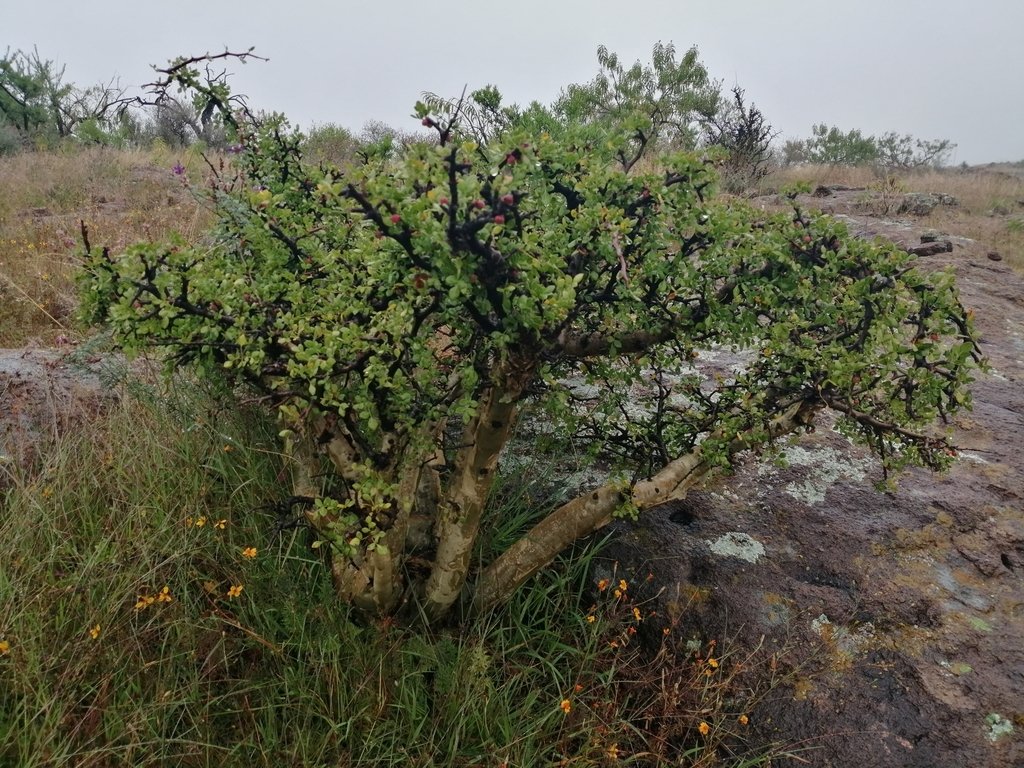Mexican Frankinsence
Bursera fagaroides
Family: Burseraceae
Deciduous shrubs to trees (in frost free areas) with shaggy peeling bark that reveals a shiny greenish trunk. Most often grown as a container plant, or in a frost-free microclimate in our region. In the wild they get about 30’ tall in protected, forested areas, about 10’ tall in open desert or thornscrub. In cultivation in Tucson or Phoenix, how large they get depends on how frost-free the location is. Plants in containers will be somewhat dwarfed. The shiny green foliage is very, very fragrant. The flowers are borne singly or in clusters at the ends of branches and are white, sometimes with a yellow or greenish tint. The gray-brown triangular fruit is about 6 millimeters long and splits open when ripe to release a seed with an orange-red aril (sticky covering on the seed).
Plant in full to part sun. Plants require low water when established, more in summer than winter. Ensure good drainage. Plants can tolerate a light frost but it’s best to protect them.
The flowers are pollinated by bees including both native and domestic honey bees. Larval host for the Ceanothus Silk Moth (Hyalophora euryalus).
The copal is burned like frankincense. The plant has many medicinal uses by the various people who live within its range. These include the treatment of headache, cuts and scratches, lice, skin diseases, sores, stingray wounds, and venereal disease. The stems are used to make coil baskets.
Photo by Ana L. Reina-Guerrero, iNaturalist
Bursera fagaroides on SEINET
There are 119 species of Bursera native (often for many species endemic) to the Americas, from the southern United States south through to northern Argentina, in tropical and warm temperate forest habitats.
The genus, Bursera, is named after the 17th-century Danish botanist Joachim Burser. The specific epithet, fagaroides, means "like Fagara" likely because the look and scent of crushed foliage is like Wild Lime, Zanthoxylum fagara.
This species is widespread across much of Mexico from Sonora to Oaxaca—this species was known from Fresnal Canyon in the Baboquivari Mountains but hasn’t been seen there since 1931. In the Waterman Mountains, there is a population of Bursera that is suspected to be a hybrid of Bursera microphylla and B. fagaroides—genetic work needs to be done on these plants to determine if that is the case.
A squat, fat specimen in Zacatecas, Mexico. Photo by Rafael Huerta Cuéllar, iNaturalist
A typical full tree (dormant), photo by María Eugenia Mendiola González, iNaturalist
A full size tree, leafed out, photo by Oscar Alejandro Morales Juárez, iNaturalist
Each seed is covered with a fleshy aril, photo by elmanu on iNaturalist
Flower detail on Bursera fagaroides, photo by Sue Carnahan, SEINET






